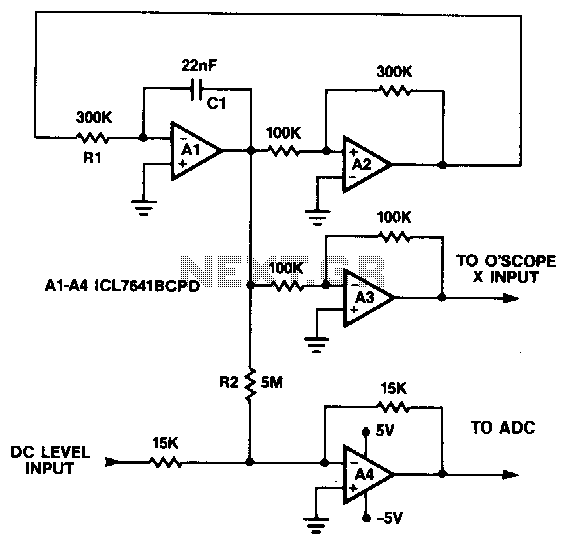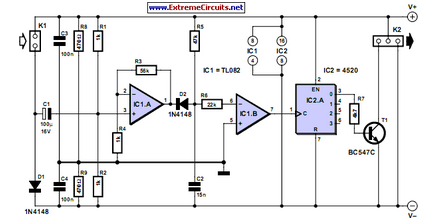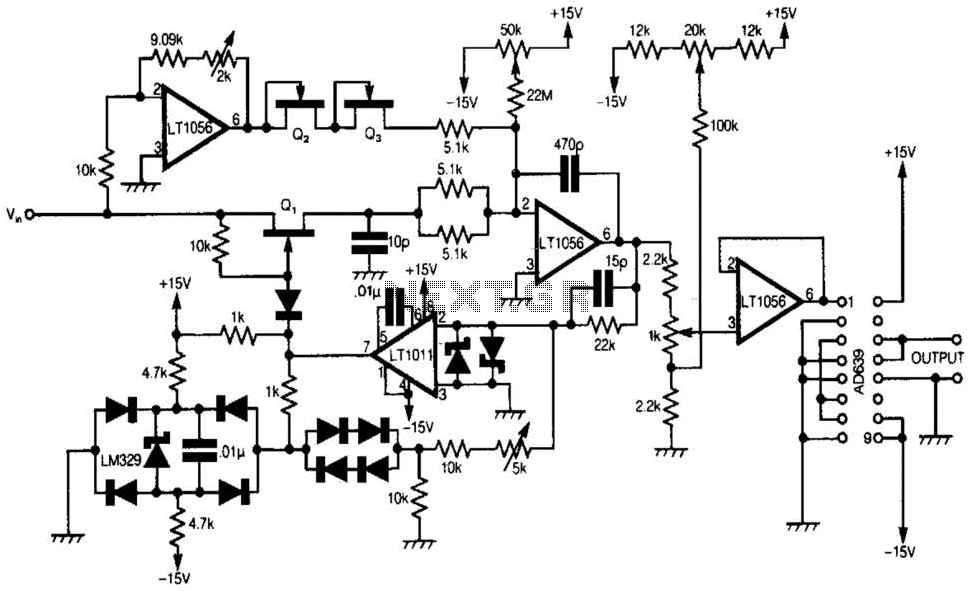
A new stable RC pulse generator

This well-known circuit can be implemented using any rail-to-rail output comparator or the classic LMC555. The output period is defined by the equation 2log(2)RC = 1.386RC, exhibiting a stability of better than ±100 ppm/°C concerning temperature variations and ±100 ppm/V regarding power supply fluctuations. However, achieving an output duty cycle different from 50:50 complicates the application of this straightforward circuit. This complexity arises because the standard modifications to the basic RC multivibrator for asymmetrical output timing either introduce undesirable interactions between the output duty cycle and period or diminish the temperature coefficient and power supply rejection ratio (PSRR). A novel approach to this traditional circuit introduces a few diodes, allowing for independent adjustment of pulse width and period while maintaining the excellent frequency stability of the standard configuration. This modification employs diodes D1 and D2 to control the positive and negative phases of the output cycle using separate timing resistors R1 and R2. Although this method is effective for achieving a multivibrator with an arbitrary on/off ratio, the temperature-dependent voltage drops across diodes D1 and D2 can significantly affect both the multivibrator's output period temperature coefficient and PSRR. To mitigate these effects, compensation diodes D3 and D4 are employed. When Vd3 equals Vd1 and Vd4 equals Vd2, the duration of the positive output pulse is determined, ensuring that static voltage drop effects cancel out and maintain the output period as defined in the original circuit without diodes. It is acknowledged that variations in charging current throughout the RC timing cycle result in non-constant voltage drops. Nonetheless, the compensation of diode effects is sufficient to ensure that matched diode temperature coefficients contribute minimally to the oscillator period's temperature dependence. The superior PSRR of the original circuit is also preserved. This new topology enables various innovative timing circuits, one of which is depicted in a separate figure. In this configuration, pulse width and frequency can be independently adjusted by resistors R1 and R3, respectively. The independence of pulse frequency from R1 is due to the total pulse period being defined by the sum of resistors (R1 + R2) = RPOT, which remains constant regardless of the potentiometer wiper's position. Meanwhile, the position of the wiper dictates the pulse width (PW = 0.693R1C), independent of R3. For most resistor values, diodes D1 through D4 can be standard switching diodes, such as the 1N4148. However, for higher resistor values where junction leakage may significantly impact performance, using transistor collector-base diodes (e.g., 2N3904) will yield better results.
This circuit design illustrates a versatile multivibrator configuration that can be adapted for various applications requiring precise timing and duty cycle control. The use of separate timing resistors allows for tailored output characteristics, making it suitable for a wide range of electronic applications, including pulse-width modulation, timing circuits, and signal generation. The careful selection of diodes and resistor values ensures optimal performance, even under varying temperature and power supply conditions. The ability to maintain stability and PSRR while adjusting pulse width and frequency independently is a significant advantage, enhancing the usability of this circuit in practical scenarios.This familiar circuit can be implemented with any rail-to-rail-output comparator or the venerable LMC555. The output period is given by 2log(2)RC = 1. 386RC, and the stability is better than ±100 ppm/ °C against temperature and ±100 ppm/V against power-supply variation.
But if an output duty cycle different than 50:50 is needed, application of this simple circuit gets complicated. That`s because the usual ways in which the basic RC multivibrator is modified for asymmetrical output timing either allow annoying interaction between output duty cycle and period or degrade the tempco and the PSRR. But a new twist to this old circuit ( Fig. 2 ) adds a few diodes to the traditional recipe to allow independent adjustment of pulse width and period while retaining the good frequency stability of the standard topology.
The new modification starts with an old idea ”addition of diodes D1 and D2 so that the positive and negative phases of the output cycle are controlled by separate timing resistors R1 and R2. This trick works well and is a handy way to implement a multivibrator with an arbitrary output on/off ratio.
The trouble is that D1 and D2`s temperature-dependent diode voltage drops (Vds) can drastically erode both the multivibrator`s output period temperature coefficient and PSRR. Canceling these effects, accomplished with compensation diodes D3 and D4, is the gimmick featured in Figure 2.
If Vd3 = Vd1 and Vd4 = Vd2, Figure 3 reveals how the duration of the positive output pulse is now given by: Static Vd effects thus cancel and leave the output period unchanged from the original Figure 1 circuit, which has no diodes at all. Admittedly, this approximation ignores the fact that due to variation in charging current over the RC timing cycle, the various Vds aren`t perfectly constant.
Even so, canceling diode effects good enough so that matched diode tempcos add no more than about + ppm/ °C to the oscillator period temperature dependence. The excellent PSRR of the original circuit is similarly preserved. The new topology makes various novel timing circuits possible, one which is illustrated in Figure 4. Here, pulse width and frequency are independently adjusted by R1 and R3, respectively. The reason pulse frequency is independent of R1 is that total pulse period is given by: But (R1 + R2) = RPOT, which is constant and independent of position the potentiometer wiper.
Meanwhile, the pot wiper position determines and, therefore, pulse width (PW 0. 693R1C) independent of R3. For most combinations of R and values, D1 through D4 can be simple switching diodes, such as the 1N4148. But for higher R values, where junction leakage can become a significant factor, better performance will be obtained if transistor collector-base diodes (e.
g. , 2N3904) are used. 🔗 External reference
This circuit design illustrates a versatile multivibrator configuration that can be adapted for various applications requiring precise timing and duty cycle control. The use of separate timing resistors allows for tailored output characteristics, making it suitable for a wide range of electronic applications, including pulse-width modulation, timing circuits, and signal generation. The careful selection of diodes and resistor values ensures optimal performance, even under varying temperature and power supply conditions. The ability to maintain stability and PSRR while adjusting pulse width and frequency independently is a significant advantage, enhancing the usability of this circuit in practical scenarios.This familiar circuit can be implemented with any rail-to-rail-output comparator or the venerable LMC555. The output period is given by 2log(2)RC = 1. 386RC, and the stability is better than ±100 ppm/ °C against temperature and ±100 ppm/V against power-supply variation.
But if an output duty cycle different than 50:50 is needed, application of this simple circuit gets complicated. That`s because the usual ways in which the basic RC multivibrator is modified for asymmetrical output timing either allow annoying interaction between output duty cycle and period or degrade the tempco and the PSRR. But a new twist to this old circuit ( Fig. 2 ) adds a few diodes to the traditional recipe to allow independent adjustment of pulse width and period while retaining the good frequency stability of the standard topology.
The new modification starts with an old idea ”addition of diodes D1 and D2 so that the positive and negative phases of the output cycle are controlled by separate timing resistors R1 and R2. This trick works well and is a handy way to implement a multivibrator with an arbitrary output on/off ratio.
The trouble is that D1 and D2`s temperature-dependent diode voltage drops (Vds) can drastically erode both the multivibrator`s output period temperature coefficient and PSRR. Canceling these effects, accomplished with compensation diodes D3 and D4, is the gimmick featured in Figure 2.
If Vd3 = Vd1 and Vd4 = Vd2, Figure 3 reveals how the duration of the positive output pulse is now given by: Static Vd effects thus cancel and leave the output period unchanged from the original Figure 1 circuit, which has no diodes at all. Admittedly, this approximation ignores the fact that due to variation in charging current over the RC timing cycle, the various Vds aren`t perfectly constant.
Even so, canceling diode effects good enough so that matched diode tempcos add no more than about + ppm/ °C to the oscillator period temperature dependence. The excellent PSRR of the original circuit is similarly preserved. The new topology makes various novel timing circuits possible, one which is illustrated in Figure 4. Here, pulse width and frequency are independently adjusted by R1 and R3, respectively. The reason pulse frequency is independent of R1 is that total pulse period is given by: But (R1 + R2) = RPOT, which is constant and independent of position the potentiometer wiper.
Meanwhile, the pot wiper position determines and, therefore, pulse width (PW 0. 693R1C) independent of R3. For most combinations of R and values, D1 through D4 can be simple switching diodes, such as the 1N4148. But for higher R values, where junction leakage can become a significant factor, better performance will be obtained if transistor collector-base diodes (e.
g. , 2N3904) are used. 🔗 External reference





